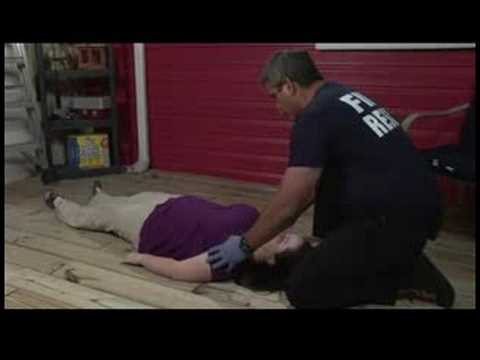Physical condition
In order to identify the casualty's condition or evaluate the extent of injuries, a quick and thorough physical assessment is required from head to toe. This is based on signs and symptoms. A head to toe assessment is only done if the casualty is conscious, or if unconscious, is breathing.
Signs and symptoms
Physical assessment can be divided into two parts: signs and symptoms.
- A sign is something another person can see, hear, or smell, such as vomit, blood, sweating, smoke and fire.
- A symptom is something the casualty can feel and can tell you about such as headache, blurred vision, dizziness and pain. In other words, you will be relying on the casualty to tell you their symptoms. If the casualty is unconscious, you will have to rely purely on signs and information given to you by witnesses.
Assessment of the casualty's physical condition should take place quickly yet carefully. Important information can be found by taking the time to thoroughly check the casualty. Start at the head and work towards the feet and pay close attention to the casualty's general appearance and behaviour. Use your gloved hands to:
- Gently slide under the casualty's back ( if possible) to check for signs of bleeding
- Gently feel for swelling, tenderness, wounds, broken bones
Obviously those with appropriate qualifications would be able to do a more comprehensive physical assessment.
Remember; do not move the casualty unless:
- They are in danger if they stay where they are, or
- They need to be moved to receive first aid
Importance of obtaining a history
As well as assessing the physical condition, it is also vital to obtain as much information as possible surrounding the accident or incident. Sometimes the nature of the illness or injury will become quite apparent from the information and history alone. You can do this by either asking the casualty or any witness's questions such as:
- What exactly happened?
- When did this happen?
- How did it happen?
Secondary examination
 Now you know the casualty's basic observations and condition, you have more time to thoroughly examine a conscious casualty by systematically looking and feeling (LAF).
Now you know the casualty's basic observations and condition, you have more time to thoroughly examine a conscious casualty by systematically looking and feeling (LAF).
- Look for deformity, wounds and swelling
- And
- Feel for deformity, tenderness and swelling
A good tool to remember the signs of injury is DOTS.
- Deformity
- Open wounds
- Tenderness
- Swelling
Conduct a head-to-toe secondary examination. Remember to be sensitive to the age, sex and culture of the casualty.
Start the secondary examination by informing the casualty of what you are going to do and the reason for doing the examination. Listen carefully to what the casualty tells you while doing your examination.
Head
- Bleeding
- Fractures
- Bruising
- Swelling
- Tenderness or pain
- Cerebral spinal fluid (CSF) from ears. CSF is a clear colourless fluid that may also have blood present
- Ask casualty to bite to check for fractured jaw
Neck
- Bleeding
- Fractures
- Bruising
- Swelling
- Deformity
- Tenderness or pain
- Numbness or tingling
- Check for medical alert necklace
- Ask casualty to wiggle fingers and toes
- Ask casualty to squeeze your hands to check for strength
Shoulders and chest
- Bruising
- Swelling
- Gently 'spring' the ribs to check for tenderness or pain
- Look for unequal rise of the chest with each breath
Abdomen and pelvis
- Rigidity
- Tenderness or pain
- Swelling
- 'Guarding' and incontinence
- Gently 'spring' the pelvis to check for tenderness or pain
Arms and legs
- Bleeding
- Fractures
- Soft tissue injuries
- Tenderness or pain
- Loss of strength
- Check for medical alert bracelet
- Check circulation in extremities
- Ask casualty to move each limb in turn
Back and spine
- Bleeding
- Deformity
- Tenderness or pain
- 'Log roll' and look at all areas of the back of the casualty for signs of injury